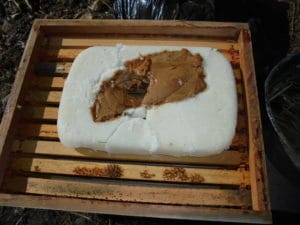I (Tina) recently bought two Pol-line queens, hoping to add some great new genetics to my bees. I pulled nucs for them both, since that is so much surer as a way to introduce a new queen…get them accepted by a nuc, then insert the nuc into the full colony. I pulled the first nuc the day before the queens were to arrive, so they had been queenless for one full day before I put her cage into the hive. Unfortunately, the nuc was from a mean colony, but it was the one in my yard most able to give up a few frames of bees and brood. Mean bees are harder to get to accept a new queen.
When I introduced the queen cage, the bees immediately balled it. You can tell the difference between a bunch of bees excited to see a new queen, and a ball of violent killers by two things. One, the size of the ball. A huge bunch of bees are aggressive, a moderate bunch of bees are just excited to see her. Two, aggressive bees bite the cage and often hold their abdomens in curved sting posture.
I almost never do a candy release. The bees can get through that candy way too fast, and this was soft candy. So, I already had a piece of masking tape over the candy to slow them down. I was thanking my lucky stars that I hadn’t cut the tiny slit in the tape that helps the bees get through it. I pressed down the edges of the tape well, and put her cage right on a brood frame.
With the second queen, I also pulled a nuc, a bigger one this time, and from a colony of nice bees. These bees were just excited to see their new queen, but just to be safe, (since I didn’t have any tape with me) I put a plastic cap over the JZBZ queen cage and that soft candy.
After 4 days, I checked both of the nucs, and neither showed any more aggression to their queens, so I gave the bees access to the candy, which should mean another day or two before she’s out.
Since queen substance is passed by touch, not scent, and the bees can’t really touch the new queen very well, they almost always start their own queen cells, even though there is a caged queen in the colony. I have learned the hard way that it is difficult to see those little queen cells covered with lots of happy nurse bees, so I’m very thorough about seeking them out. I blow the bees off of every frame, including honey frames, and really look for queen cells, and cut them out very well, not just taking the wax off from over the larval queens, but scooping them out so they can’t be repaired.
After 5 more days I checked both nucs again, expecting to see fresh eggs and hatched larvae in both. Not so! Both had re-started queen cells with too-old larvae. In the first one I checked, the big nuc with nice bees, I looked very carefully for eggs or larvae and could find none. I cut out the intercaste queen cell and combined with the colony next door, which also had a new queen, but needed more bees.
When I checked the small nuc with mean bees, and saw two new queen cells, I was so disgusted that I just closed it up and walked away to give myself time to decide what to do with them. I called a friend who also had two new Pol-line queens. She had tossed hers in nucs as well, but gave the bees access to the candy and went on vacation after cutting out the queen cells. When she came back, she also found more new queen cells, but also found her new queens laying well and apparently happy.
After hearing her story, I went back out and checked my mean nuc with the two new queen cells. Sure enough, there was my nice new, red queen, having laid just a few eggs and with just a few just-hatched larvae. The larvae were so full of jelly, I had to look really closely to be sure that it wasn’t just jelly with no baby. So glad I called my friend! The two queen cells were just fine, getting ready to emerge, since the nurses had removed the wax covering the tips of their cells. Why hadn’t the new queen killed them? What was she thinking?
I pulled the queen cells out to a mating nuc (even though they’re mean, and probably intercaste, but they were normal-sized) and marked my new girl. So exciting!
Moral of the story…talk to your bee friends about what is going on, and pay attention. And, never give up… never surrender. Those darn bees don’t read the book!


